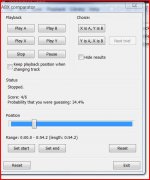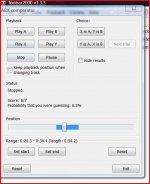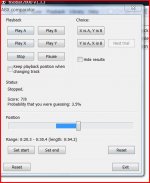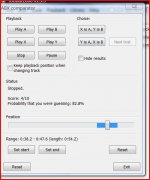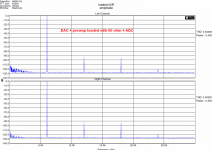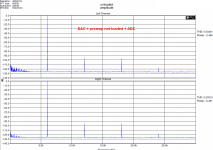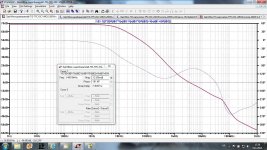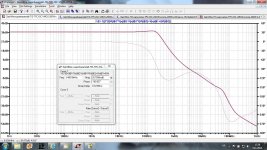No, on the files that passed through the playback/record chain, there were 4 of them - the Direct wav is clean.
I've noticed this when just looking visibly at the Audacity trace. I've even tried attenuating the line signal (2k2 and 680 ohm divider) and I still see what you mention. I noticed it on SY's test track too when played and recorded and yet the original is clean. It didn't matter whether I turned the level down on Audacity or used the attenuator or both. It was present. Audacity doesn't show clipping as present when recording or on playback for me.
Limitation of the ADC ?
Attachments
test loaded x unloaded
Karl, I have used your Direct WAV file to create 2 files, one with unloaded preamp output, second with heavily loaded preamp output. If anyone would like to try and give his opinion which is which, here is the link:
https://www.dropbox.com/s/sndn8jpl5hlfigo/manchester.zip?dl=0
This test is completely unscientific, only two files and almost everything revealed 😛
Karl, I have used your Direct WAV file to create 2 files, one with unloaded preamp output, second with heavily loaded preamp output. If anyone would like to try and give his opinion which is which, here is the link:
https://www.dropbox.com/s/sndn8jpl5hlfigo/manchester.zip?dl=0
This test is completely unscientific, only two files and almost everything revealed 😛
Assuming with 'response curve' do you mean the THD response, lets say we have these two cases:
case A; amp has -120dB THD at 100 Hz, rising to -80dB at 20kHz;
case B; amp has flat -80dB THD from 100Hz to 20kHz.
So you would prefer case B?
Good question. I believe that you also read below thread?
http://www.diyaudio.com/forums/solid-state/240712-cfa-topology-audio-amplifiers-637.html#post4104737
In above thread MiiB posted AC response analysis that is -60dB, rising at 2kHz. Then based on Esperado suggestion MiiB modified the circuit to have a flatter response that is rising at 10kHz but now at -45dB 🙂
Amplifier design is such an art that almost everything has compromise or trade-off. It is then necessary to set up standards. Each designer I suppose have their own formula/standards. In this case (VAS input response), it could be a minimum of 10kHz, a minimum of -60dB, or even more complex standards. Not a good thing to discuss as it is debatable, but could be kept as "design secret" 😀
You should like the file names. A reminder of my visit to Manchester area 🙂
Indeed. The Last Drop 🙂
Oky dokey. Here are the Foobar runs (I felt I preferred B which would be Bolton ?) although the Foobar results are inconclusive.
These runs were done in succession with no prior listening or conditioning (of me 😀) Run 2 and 2a is simply because I forgot to reset Foobar and so just carried on unknowingly. So run 2a is just run 2 with as it happened, more correct answers. That part of the track is where I seemed to be on to something.
I also felt sure I was hearing things that I didn't remember in the original (this was using Sony MDRV7 headphones, I usually use speakers, and it is actually a long time since I have played this track). A check with the original reveals the same difference... I honestly thought I heard a faint, well a faint "siren" rising and falling type sound... so much so I paused it and the noise stopped. The player breathing ? I just don't recall ever hearing that before.
I must try the original disc on the Marantz to confirm the sound.
Attachments
Attachments
I must try the original disc on the Marantz to confirm the sound.
Its present when listened to on a player. From 20 to 25 seconds, more left channel biased. Just never picked up on it before.
Amplifier design is such an art that almost everything has compromise or trade-off.

(the art of engineering is all about developing the optimal solution for a predefined task)
Its present when listened to on a player. From 20 to 25 seconds, more left channel biased. Just never picked up on it before.
With headphones you have much higher resolution. You may pick up something with headphones that you have never noticed before with speakers.
I have just tried your "Direct WAV" against Either "bolton" or "blomley", without much concentration I did not pick the difference. My bad, should have been bromley 🙂
Attachments
So, which is which? This might be a challenge to golden ears 😉
One is with preamp without additional load, the other is with preamp loaded by 60 ohm (sixty, not six hundred).
Whole chain DAC - preamp (with or without load) - ADC measures like this at 0dBFS.
https://www.dropbox.com/s/sndn8jpl5hlfigo/manchester.zip?dl=0
One is with preamp without additional load, the other is with preamp loaded by 60 ohm (sixty, not six hundred).
Whole chain DAC - preamp (with or without load) - ADC measures like this at 0dBFS.
https://www.dropbox.com/s/sndn8jpl5hlfigo/manchester.zip?dl=0
Attachments
Last edited:
He might put the resistor to load the VAS to get the desired effect. The debate is close to useless.
Precisely, Pavel.
I base my views on my own experiece with a hell of a lot of amps which have gone through my house door in and out.
The smaller the open loop gain, the less GNB we need, however, the distortions are usually lower as well (less gain, less distortion). And the wider the OL bandwidth.
As opposed to Esperado, I am not happy at all if my amp has an OL bandwidth of less than 40 kHz, and I'm happy when I manage something like 130 kHz. Take a look at Metaxas schematics and you'll see they are worse than me, they get over 200 kHz.
My 40 kHz bandwidth is really just like John's, arbtitrariuly enriched with my usual shying away from too close a shave. If I really need 20 kHz, I should have at least some reserve. And why not? H/K 680 integrated amp has just 12 dB of GNFB and a guaranteed close loop bandwidth of 270 kHz, thus presumably having around 80 kHz of OL bandwidth. And it's a relatively simple circuit, much along the Otala/Lohstroh lines.
Ultimately, I don't really even need GNFB, if my ciruits do THD of 0.3% or less without any, except for two aspects: improved stability and reduced output impedance, or e better damping factor. And my own experience - of several zero GNFB amps I have heard, however different they sounded, one thing was common to all, they left me with a sound that to me seemed unfinished, as if something was left out. As if the sound was a little out of control. Just my impressions.
I believe THD and IM measurements have very little, not to say anything, to do with soud quality, assuming good stability and a "regular" hramonic decay (meaning they decay as they should, with no funnies, like the 7th harmonic being above the level of say the 2nd harmonic). However, please bear in mind that this is an oversimplification on its own, out of the context of the amp as a whole, whose list of requirements to sound good is much longer and much more involved.
Also, this is NOT to say that an amp complying with these requirements will by default sound better than its high GNFB counterparts by default. I think we all know how complex a set of trade-offs any amp is, ceratinly way above reducing it to any two things alone. After all, if my !"#$%&/()=? passive crossover ate up four months of development to finally come to life, just imagine the development work needed for a much more complex piece of electronics such as a power amp.
These are my thoughts only, and certainly no general truth. So far, they have served me well, so I'll stick by them until they start failing me.
Last edited:
Pavel,
This just shows that you have a pretty good preamp and that my ears are shot, since they can't pick up a difference of 0.00001% in distortion.
Tried it in Foobar over speakers couple of times and can't beat the odds.
This just shows that you have a pretty good preamp and that my ears are shot, since they can't pick up a difference of 0.00001% in distortion.
Tried it in Foobar over speakers couple of times and can't beat the odds.
OT (just a bit): Harry Pearson passed away yesterday. Another legend bites the dust...
Met him a few years back, at an RMAF showing off my very first L|A volume, managed to get him to sign it.
I think he felt sorry for me in some way, which I slowly start to understand. 😉
jan
Met him a few years back, at an RMAF showing off my very first L|A volume, managed to get him to sign it.
I think he felt sorry for me in some way, which I slowly start to understand. 😉
jan
Precisely, Pavel.
I base my views on my own experiece with a hell of a lot of amps which have gone through my house door in and out.
The smaller the open loop gain, the less GNB we need, however, the distortions are usually lower as well (less gain, less distortion). And the wider the OL bandwidth.
As opposed to Esperado, I am not happy at all if my amp has an OL bandwidth of less than 40 kHz, and I'm happy when I manage something like 130 kHz. Take a look at Metaxas schematics and you'll see they are worse than me, they get over 200 kHz.
My 40 kHz bandwidth is really just like John's, arbtitrariuly enriched with my usual shying away from too close a shave. If I really need 20 kHz, I should have at least some reserve. And why not? H/K 680 integrated amp has just 12 dB of GNFB and a guaranteed close loop bandwidth of 270 kHz, thus presumably having around 80 kHz of OL bandwidth. And it's a relatively simple circuit, much along the Otala/Lohstroh lines.
Ultimately, I don't really even need GNFB, if my ciruits do THD of 0.3% or less without any, except for two aspects: improved stability and reduced output impedance, or e better damping factor. And my own experience - of several zero GNFB amps I have heard, however different they sounded, one thing was common to all, they left me with a sound that to me seemed unfinished, as if something was left out. As if the sound was a little out of control. Just my impressions.
I believe THD and IM measurements have very little, not to say anything, to do with soud quality, assuming good stability and a "regular" hramonic decay (meaning they decay as they should, with no funnies, like the 7th harmonic being above the level of say the 2nd harmonic). However, please bear in mind that this is an oversimplification on its own, out of the context of the amp as a whole, whose list of requirements to sound good is much longer and much more involved.
Also, this is NOT to say that an amp complying with these requirements will by default sound better than its high GNFB counterparts by default. I think we all know how complex a set of trade-offs any amp is, ceratinly way above reducing it to any two things alone. After all, if my !"#$%&/()=? passive crossover ate up four months of development to finally come to life, just imagine the development work needed for a much more complex piece of electronics such as a power amp.
These are my thoughts only, and certainly no general truth. So far, they have served me well, so I'll stick by them until they start failing me.
What is your opinion coming from your experience wich one of those two amps will sound better? Those plots show a Loop Gain.
Attachments

(the art of engineering is all about developing the optimal solution for a predefined task)
Developing optimal solution for a predefined task is the engineering, the Math. Defining the task is the Art.
Define your amplifier design objective and let's see if you're good at Art 😀
Developing optimal solution for a predefined task is the engineering, the Math. Defining the task is the Art.
No, mostly business/marketing.
Jay, you make a good point. Many here keep asking me about specific circuits, when what I am trying to convey is
'what is important' in an audio design? Fancy circuits improperly implemented, will not give the best results.
'what is important' in an audio design? Fancy circuits improperly implemented, will not give the best results.
What is your opinion coming from your experience wich one of those two amps will sound better? Those plots show a Loop Gain.
I have no idea, nor will I have any until I can hear them both in action.
As I said, open loop bandwidth is just one of many aspects of an amplifier, and in iteslf, it guarantees little if anything, as there are many other aspects in which one can go wrong.
Ditto for any other aspect you care to name.
But, when it all comes together in harmony, meaning no outright mistakes anywhere, all other things being equal between two amps, I believe the one using less GNFB because it has a higher open loop bandwidth has a better chance of sounding better.
That said, I must also add that not all amps with small GNFB factors were to my liking, just as I have heard a number of amps using a lot of GNFB which neverthless did sound very, very good.
One thing I do claim, again from personal experience: the amount of measured THD and IM, as we do it now, has very little to do with the sound we hear. I find it symptomatic that almost as a rule amps with THD and IM spec of say 0.05% will most probably sound better than amps with 0.005% of the same. If you dig deep enough, do not be surprised if you find that the poorer measuring one use less GNFB than the better measuring ones.
- Status
- Not open for further replies.
- Home
- Member Areas
- The Lounge
- John Curl's Blowtorch preamplifier part II

